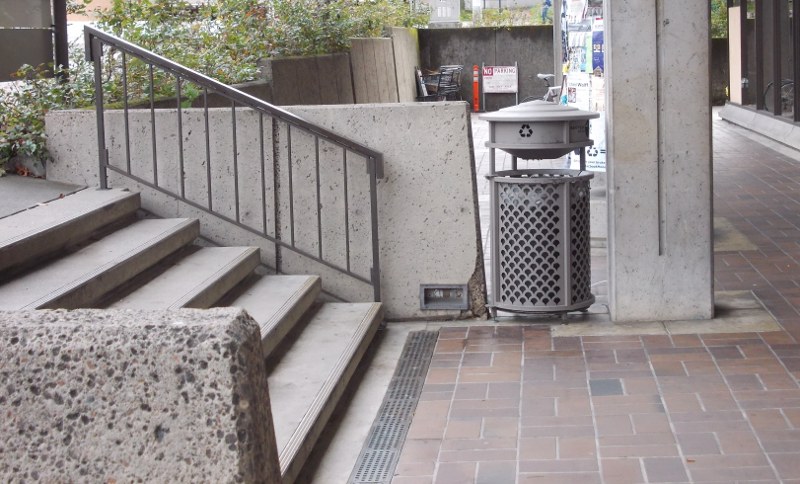Traffic improvements may sometimes be cheap. Below I show how to enhance the walkways around a University of Washington (UW) building, Schmitz hall, in Seattle at University Way and 41th street.
A bit of background. University Way is a lively shopping street one block west of the UW campus. It is a major pedestrian destination and also an important connection street. UW campus begins one block east of it, on the other side of 15th avenue. At the end of Campus Parkway (40th street) there is a much used walkbridge over 15th. Schmitz hall is located just between the walkbridge and University Way and hence a major walking corridor embraces it from both sides.
Let's start from north, approaching the campus from University Way (see the picture). We don't want to follow the sidewalk straight down (south)—then we have to climb up later again to reach the walkbridge. We take instead the level walkway around the hall, either by turning left, or south. However, as you can see, the most direct route to the walkway is blocked by a small decorative wall. This is the first cheap improvement: just remove the wall.

Compared to typical Seattle sidewalks, the walkway is surprisingly spacious. Unfortunately, a half of it is blocked by short stairs, leading to the sidewalk at about 1m above it (see the picture below). This makes a large swath of the walkway unsuitable as a connector route. I don't know if it is used for anything else. Note that even the narrow gap between stairs and a concrete pillar is blocked by a trashcan.

But the next picture indicates just how easy it is to recover almost half of its walkable width: a) move the bin; and b) remove the lower part of the concrete wall that lines the stairs. Metal handrails are enough for safety. You may even shorten the handrails a bit at the lower end. This is easy and cheap.

The next obstacle is a bike rack. Well, not the rack itself but the bikes that extend far out of the rack. Fortunately the solution is easy: turn the rack 90 degrees and move it over to the left side.

After passing the rack we reach the bridge with no further obstacles. However, there is another issue that can easily be solved. A bus stop is located at the 15th avenue, just at the end of the footbridge. Unfortunately, as the street is about 1m lower than the walkway at the end of the footbridge, one has to walk around the waiting shelter ("out of the picture" on right-hand side). This adds about 15 seconds to the walking time compared to the direct route.


*
We need more attention to small details when desiging transportation infrastructure. The examples above indicate that improvement can sometimes be achieved with very little costs, or even at no cost if such considerations are taken into account in the original design. We need more awareness and understanding of pedestrian mobility at least as much as money. In this case it is about directness and space: we don't want to go around if a direct route is just here, and we don't like narrow passages.
*
AD ENDUM: I moved the bike rack out of way.

No comments:
Post a Comment